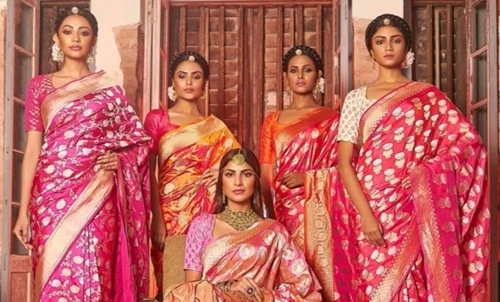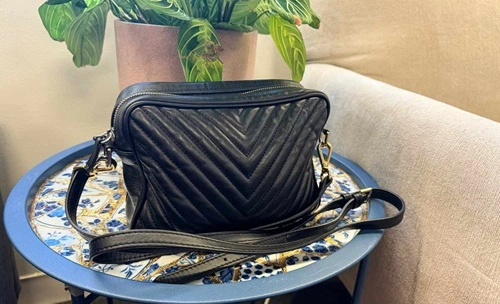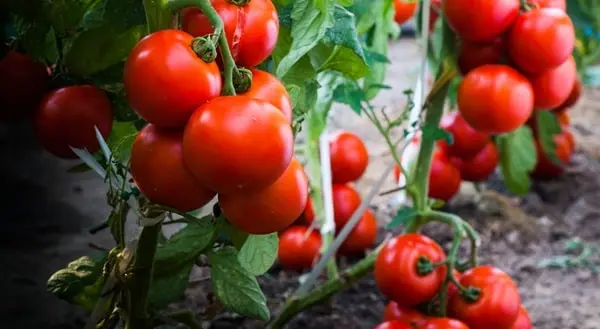India has a rich cultural heritage of handloom weaving, and the handloom saree is the reflection of this rich heritage. Each area in India has its own weaving method, fabric, and pattern, making Indian handloom sarees the most desirable around the world. From the stylized Banarasi sarees to the colorful Pochampally ikat weaves, every region in India produces sarees depicting the culture and craftsmanship of the place.
1. Varanasi, Uttar Pradesh (Banarasi Saree)

Banarasi sarees of Varanasi are renowned for their opulent silk, brocade work, and intricate patterns. They are usually made in fine silk with motifs of paisleys, flower patterns, and religious motifs. The Banarasi Georgette saree is a modern variation of a traditional saree made out of lighter fabrics. The Banarasi saree in hues of orange and peach is suitable for weddings and festive occasions and exudes richness and sophistication.
2. Kanchipuram, Tamil Nadu (Kanchipuram Saree)
Tamil Nadu’s Kanchipuram sarees are renowned for their weighty silk and intricately detailed zari work. Sarees are typically in vibrant colors, and are a hit at weddings and celebrations. Renowned for their weighty, thick material and wide borders, Kanchipuram sarees are designed to make a real impact with their grandeur and work.
3. Mysore, Karnataka (Mysore Silk Saree)
Mysore is famous for its exquisite Mysore silk sarees, woven from the finest quality of mulberry silk. The sarees are well-known for their silky smoothness, soft sheen, and simple appearance, generally with light zari patterns along the edge.
4. Pochampally, Telangana (Pochampally Ikat Saree)
Pochampally stands distinguished for its distinctive weaving technique where yarns are pre-dyed before weaving to unlock fabulous geometric patterns. Pochampally sarees, woven in the materials of cotton, silk, and Georgette, feature lovely colors along with intricately done work showcasing the high culture of the place. Sarees find preference due to their beautiful look as well as classical appeal.
5. Chanderi, Madhya Pradesh (Chanderi Saree)
Chanderi sarees are famous for being light in weight, airy texture and subtle crafting. The sarees, fabricated from cotton and silk and in some cases with a mixture of both, bear delicate designs in the form of florals and geometric motifs. Chanderi sarees are fit for seasonable affairs and provide an element of gracefulness and relaxation.
6. Bhagalpur, Bihar (Bhagalpuri Silk Saree)
Bhagalpur of Bihar is famous for its Bhagalpuri silk, which is a distinctive type of tussar silk. The sarees are woven from the natural fiber and are much sought after for their texture, luster, and endurance. Bhagalpuri sarees tend to have earthy colors, and orange sarees and peach sarees are usually preferred. The simplicity and earthy look make them a go-anywhere choice for both traditional and informal occasions.
7. Nagaland (Naga Saree)
Nagaland handloom sarees are unique in their application of natural dye and tribal design. They are typically fabricated using cotton or wool, while the sarees exhibit earth colors and vibrant tones. The original design, being inspired by Naga culture, comprises geometric designs and symbolic prints, thus creating a special selection for women to choose from while being culturally educated.
8. Sambhalpuri, Odisha (Sambhalpuri Saree)
Sambhalpuri sarees from Odisha are hand woven in the traditional Ikat process where yarn is dyed before weaving to develop fine patterns. Sarees are typically of silk or cotton material with vibrant colors. Sambhalpuri sarees are highly prized for wedding and festive wear due to the richness in patterns and richness in cultural significance.
9. Assam (Muga Silk Saree)
Muga silk, which is specific to Assam, is the bedrock of the state’s handloom sarees. These sarees are made from the golden-coloured silk that the Muga silkworm spins, and the sarees are characterized by their beautiful sheen and longevity. Muga silk sarees tend to be colourfully dyed, which look opulent yet natural. These sarees are ideal for someone who loves top-class craftsmanship and ageless elegance.
10. Bengal (Baluchari and Tant Saree)
Bengal is well known for its handloom sarees, specifically the Baluchari and Tant sarees. Baluchari sarees are well known for their intricate woven designs, which usually portray mythological themes. Tant sarees, which are crafted from fine cotton, are lightweight and breathable in texture. Both types are available in a variety of colors. The sarees are well liked for their ageless charm and versatility.
11. Kashmir (Pashmina Silk Saree)
Kashmir has been renowned for its opulent Pashmina silk, which is a type of fabric soft, warm, and best suited for the colder climate of this region. Kashmiri Pashmina silk sarees are resplendent in their intricate designs through embroidery with Sozni work and the soft, gentle hues of peach or bright warm shades of orange.
12. Udupi, Karnataka (Udupi Saree)
Udupi, a small town in Karnataka, is famous for its quality cotton handloom sarees that are light, airy, and comfortable. Udupi sarees are mostly made with subtle yet elegant patterns and in various colors. Udupi sarees’ flexibility and softness make them extremely popular for regular wear as well as for semi-formal occasions.
13. Jaipur, Rajasthan (Sanganeri Saree)
Jaipur, the city of Rajasthan, is famous for its Sanganeri handloom sarees, distinguished by their block printing and floral designs. They are made of light cotton and are comfortable to wear due to the hot climate of Rajasthan. Sanganeri sarees come in a range of colors such as loud orange and pale peach, so they also become a favorite during summer as well as festive seasons.
14. Coimbatore, Tamil Nadu (Coimbatore Saree)
Coimbatore, which is a large textile center in Tamil Nadu, weaves a range of handloom sarees, particularly in cotton. Coimbatore sarees, being plain yet stylish, are ideal for both formal and informal wear.
15. Surat, Gujarat (Kota Doria Saree)
Surat is famous for its Kota Doria sarees, made from a light, airy material with a special crisscross weave. These sarees provide a light, easy-going appearance ideal for tropical climates. Kota Doria sarees are favored for their comfort and beauty, hence ideal for daily wear and festivals.
Conclusion
From the grandeur of Banarasi sarees to the plainness of Udupi sarees, to the intricate designs of Pochampally sarees, the garments keep individuals fascinated with their elegance, sophistication, and craftsmanship. Handloom sarees remain a part of India’s cultural heritage, celebrated for their uniqueness and the history they present through their intricate designs.

